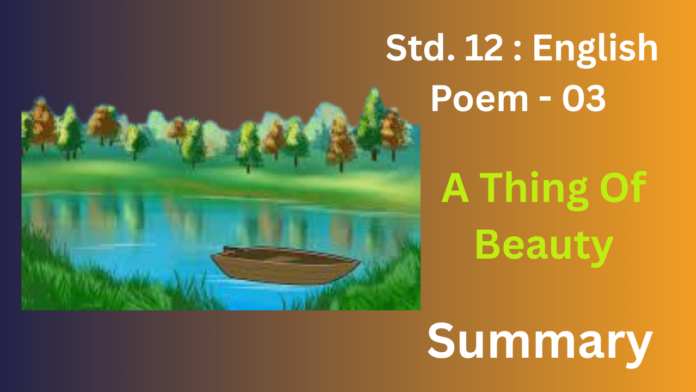John Keats’ “A Thing of Beauty” celebrates the eternal and uplifting power of beauty in all its forms. The poem argues that beauty provides lasting joy, its loveliness growing constantly and never disappearing. It offers a peaceful refuge, a “bower quiet” and restful sleep filled with “sweet dreams, and health, and quiet breathing.”
Keats then enumerates various sources of beauty that sustain us amidst life’s hardships and sorrows: the sun, moon, trees, daffodils, clear streams, ferns, and fragrant roses. He emphasizes that these beautiful things, both grand and simple, act as a continuous source of hope and inspiration, a “flowery band to bind us to the earth”. Ultimately, the poem is an ode to the enduring comfort and joy that beauty offers, a timeless antidote to human suffering and despair.
Exercise
Think it out
1. List the things of beauty mentioned in the poem.
Ans:
The things of beauty mentioned in John Keats’ poem “A Thing of Beauty” are:
- The sun
- The moon
- Old trees
- Young trees
- Daffodils
- Clear rills (small streams)
- The mass of ferns
- The blossoming of musk-rose flowers
- Grandeur associated with the mighty dead (noble deeds and achievements of great people)
- Lovely tales that we have heard or read (legends and stories)
- An endless fountain of immortal drink (beauty from nature and art, like a continuous source of joy) pouring unto us from the heaven’s brink.
2. List the things that cause suffering and pain.
Ans:
In John Keats’ poem “A Thing of Beauty,” the things that cause suffering and pain are mentioned in contrast to the sources of beauty. They include:
- The pall: This refers to a covering or a sense of gloom and darkness that overshadows our spirits.
- Our dark spirits: This suggests a state of sadness, negativity, and despair within ourselves.
- The inhuman dearth of noble natures: This points to a lack of kindness, compassion, and virtuous qualities in humanity.
- The gloomy days: These represent periods of sadness, hardship, and despair in life.
- The o’er-darkened ways: This refers to the difficult and troubled paths we sometimes have to navigate in life.
- Made for our searching: This implies the struggles and frustrations we face in our pursuit of happiness and fulfillment.
- Spite of despondence: This refers to feelings of hopelessness and discouragement.
3. What does the line, ‘Therefore are we wreathing a flowery band to bind us to earth’ suggest to you?
Ans:
The line, ‘Therefore are we wreathing a flowery band to bind us to earth’ suggests that beautiful things act as a vital connection to life and make our earthly existence bearable despite suffering. This bond helps us endure the pain and negativity (“our dark spirits,” “gloomy days”) by providing solace, hope, and a reason to remain connected to life. It implies that beauty is not just an aesthetic pleasure but a fundamental human need that anchors us and sustains us through difficult times.
4. What makes human beings love life in spite of troubles and sufferings?
Ans:
Despite the presence of troubles and sufferings, human beings are drawn to life by the existence of beauty in the world around them. This inherent human appreciation for beauty acts as a “flowery band,” connecting us to the earth and making life worthwhile.
Beyond external beauty, inner resources like hope, resilience, the capacity for love and connection, and the search for meaning and purpose also play crucial roles. Even in the face of adversity, people find strength in their relationships, their dreams for the future, and the belief that even suffering can lead to growth or a greater appreciation for life’s precious moments. The human spirit’s remarkable ability to adapt, find joy in small things, and hold onto hope are powerful forces that enable us to love life despite its inevitable challenges.
5. Why is ‘grandeur’ associated with the ‘mighty dead’?
Ans:
‘Grandeur’ is associated with the ‘mighty dead’ because their significant achievements, heroic deeds, and impactful lives leave behind a lasting legacy of greatness and admiration. These individuals, through their actions and contributions, often overcome challenges and achieve remarkable feats that inspire awe and respect across generations.
Their stories are retold and celebrated, their accomplishments remembered, and their influence often continues long after their physical passing.This enduring impact, coupled with the often larger-than-life nature of their achievements, imbues them with a sense of majesty and importance – hence, ‘grandeur.’ Their lives become narratives of exceptionality, setting them apart and associating them with a form of noble and impressive greatness that transcends ordinary existence.
6. Do we experience things of beauty only for short moments or do they make a lasting impression on us?
Ans:
In John Keats’ “A Thing of Beauty,” the poem suggests that things of beauty have a lasting impression on us, rather than being fleeting experiences.
While the immediate experience of beholding something beautiful might be momentary, its impact on our minds and spirits can be profound and long-lasting. The poem describes how beauty provides a “bower quiet” and “sleep full of sweet dreams,” suggesting a continuous, soothing influence. The memory and the emotional resonance of a beautiful experience can stay with us, offering solace and hope even long after the initial encounter. Therefore, according to Keats, the true value of beauty lies in its enduring effect on our lives, acting as a constant source of joy and inspiration.
7. What image does the poet use to describe the beautiful bounty of the earth?
Ans:
To depict Earth’s beautiful abundance, the poet employs the metaphor of an “everlasting spring of immortal beverage.” This spring is depicted as “flowing towards us from heaven’s edge,” indicating a perpetual and divine origin for all the exquisite elements nature provides. This potent imagery conveys the boundless and life-affirming nature of Earth’s beauty, suggesting it’s a constant and inexhaustible source of delight and motivation, akin to a fountain that never empties and offers a drink promising eternal life (in the sense of enduring joy and spiritual sustenance).


